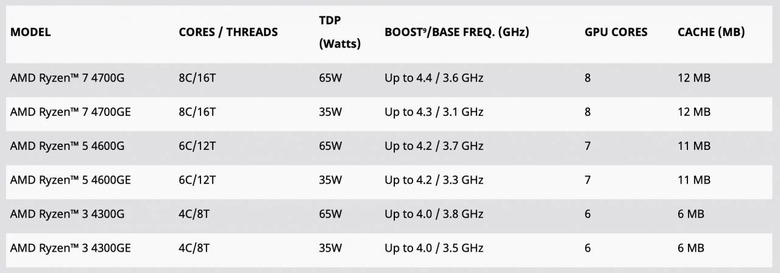AMD Ryzen 4000G Desktop Chips Land With Big Intel Comparisons
AMD's latest assault on Intel has been revealed, with the AMD Ryzen 4000G chips promising a taste of Zen 2 for your desktop. The new processors are the desktop counterpart to AMD's Ryzen 4000 Series for laptops, which the chip-maker released earlier in 2020, and still include features like integrated graphics.
It's the first 8-core desktop APU from AMD, with the G-Series focusing on consumers while the Ryzen 4000 Series PRO take on business PCs. There'll be six variants to begin with in each category.
For consumers, the flagship is the AMD Ryzen 7 4700G, with eight cores and 16 threads. It has a TDP of 65W, a base frequency of 3.6 GHz, and a boost frequency of up to 4.4 GHz. It also gets 12MB of catch, and 8 Radeon cores. A Ryzen 7 4700GE version will drop the TDP to 35W, slightly sacrificing base and boost frequency (3.1 GHz and 4.3 GHz, respectively) in the process.
The Ryzen 5 4600G and Ryzen 5 4600GE follow the same strategy, with 65W and 35W TDP respectively. Each have six cores and 12 threads, with 7 Radeon GPU cores and 11 MB of cache. The 4600G runs with a 3.7 GHz base frequency and up to 4.2 GHz boost, while the 4600GE is 3.3 GHz base and 4.2 GHz boost.

Finally, the AMD Ryzen 3 4300G and 4300GE have four cores and eight threads, with the same 65W and 35W TDPs. Both have 6MB of cache and six GPU cores, with the 4300G running at 3.8 GHz base and up to 4.0 GHz boost. The 4300GE has a 3.5 GHz base frequency and up to 4.0 boost.
Compared to the old Ryzen 5 3400G and Ryzen 3 3200G, AMD claims there's up to 2.5x the multi-threaded performance from the new processors. Versus an Intel Core i7-9700, meanwhile, the claim is up to 5-percent greater single-thread performance, and up to 31-percent greater multithreaded performance. AMD says its integrated Radeon graphics are up to 202-percent better than the integrated graphics on the Intel chip, too.
Of course, that doesn't take into account Intel's beefiest 10th Gen processors, which run all the way up to 125W TDP. We're also going to have to wait to see just how much can be coaxed out of the Ryzen 4000 Series by enthusiasts. That's because, at least for the moment, AMD isn't planning on offering the AM4 processors to end users.
Instead they'll be available through OEMs, as prebuilt systems. Expect to see plenty of those crop up from the usual suspects over the coming weeks, as the 7nm Zen 2 cores proliferate.
